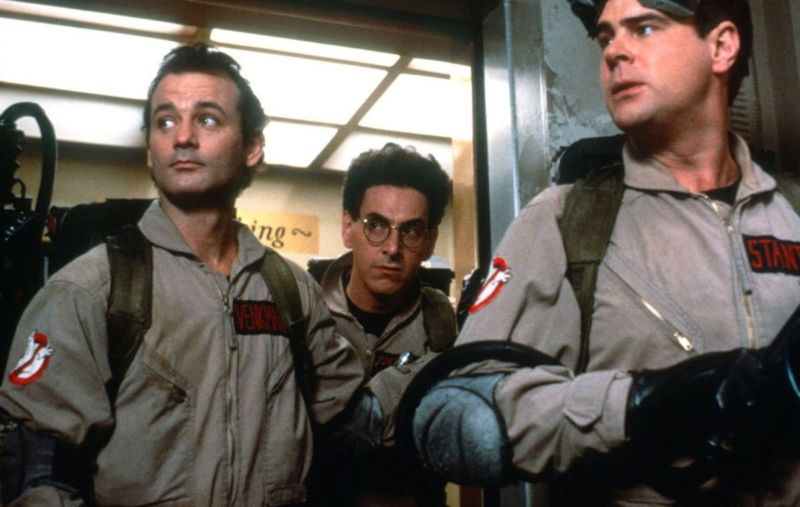
“Ghostbusters has a perfect story arc.”
Of all the valuable ideas I heard in class during my years pursuing an MFA, this sentiment, articulated by a fellow student, might be the thing I think about the most. This is partly because I spent my childhood watching and rewatching Ghostbusters, forming strong opinions about the sequel (no) and the children’s cartoon version (surprisingly not terrible!), and playing with my brother’s Ghostbusters action figures, complete with a firehouse/Ghostbusters headquarters, which came with a container of slime you were supposed to pour through the roof for—reasons? (Mom forbade us to do the slime-pouring because the stuff was hell on the carpet.)
But it’s also partly because when I paused long enough to consider what this fellow student had said, I realized he was right. Ghostbusters is a perfect example of Freytag’s Pyramid—that most basic of narrative structures that happens in five distinctive parts: exposition, rising action, climax, falling action, denouement. If you chart it out, the plot follows the arc exactly:
Exposition: We meet three scientists who get fired from their university and helpfully exposit that they’re all broke and that they’re researching how to hunt and capture ghosts. It’s the Regan era, so they decide to become capitalists by going into the ghostbusting business.
Rising Action: The Ghostbusters begin taking on clients, each of whom leads them closer to a central, cataclysmic event that is about to take place.
Climax: The Ghostbusters confront the main bad-guy ghost, Zuul, who arrives in the form of the Stay-Puft Marshmallow Man and wreaks havoc on the city before our heroes take a chance on crossing the streams of their proton packs, exploding Mr. Stay-Puft and saving Bill Murray’s would-be girlfriend, Sigourney Weaver, who had previously been turned into a demon dog.
Falling Action: Having saved the day, the busters reflect on the science of ghosts, Rick Moranis’s prospects for becoming their accountant, how much they love New York City. They realize that after being covered in marshmallow goo, their dry cleaning bill will be astronomical. Murray and Weaver kiss.
Denoument: New York City celebrates the Ghostbusters’ triumph.
What intrigued me about my fellow student’s observation was that he’d looked at something I’d taken for granted, something I considered just “for fun,” and he’d recognized the value it had in helping him understand something about writing. Movies are a pretty obvious place for fiction writers to find examples of good storytelling—but I’d kept the two things separate in my mind, one in the “work” column and one in the “entertainment” column.
Soon, I was looking beyond movies, at other things I’d previously considered “just fun,” for what they could teach me about my own writing. When I took up running, I spent the miles I logged thinking about how I spent most of a run tolerating the painful or boring moments to get to the good runner’s-high parts—and how that was a lot like writing a novel, where I spent a lot of time tolerating my own bad writing in order to get to those brief moments where I’m firing on all cylinders and getting something truly good on paper. I played a zombie card game with my friends and recognized that the split-second decision-making I was using when confronting dead-ends, combating my opponents, and working my way toward a winning move was similar to the kind of thinking on my feet I did in a first draft, when my own writing surprised me into seemingly inescapable plot cul-de-sacs.
As the saying goes, there’s no accounting for taste. We like what we like, and we can’t always explain why we like those things. But what we like—the pop culture we consume, the hobbies we take up, even the kinds of food we prefer—can not only reflect our writing and help us understand it better; it can give us models for writing. My favorite thing to do now is figure out how I can find new forms or structures for writing in the things that I like. Could I, for instance, write a story that unfolds the way your perception does when you look at a painting—could I layer my story in the way the paint is layer on canvas? Or could I create a scene that has the rhythms of my favorite song from Hamilton? Or maybe I’ll try “piecing” together an essay in the manner this writer describes, in her exploration of what quilting taught her about narrative forms.
What we like can do so much for our writing, including challenging us to come at our fiction in novel ways. So don’t segregate your likes into the “for fun” column and forget about them when you get down to work. Investigate your likes. Interrogate them. Ask yourself: Why do you like what you like—and how can it help you become a better writer?
Editor’s Note: Author Jamey Bradbury is teaching a writing workshop on October 20 in Anchorage. Signups are open now.
